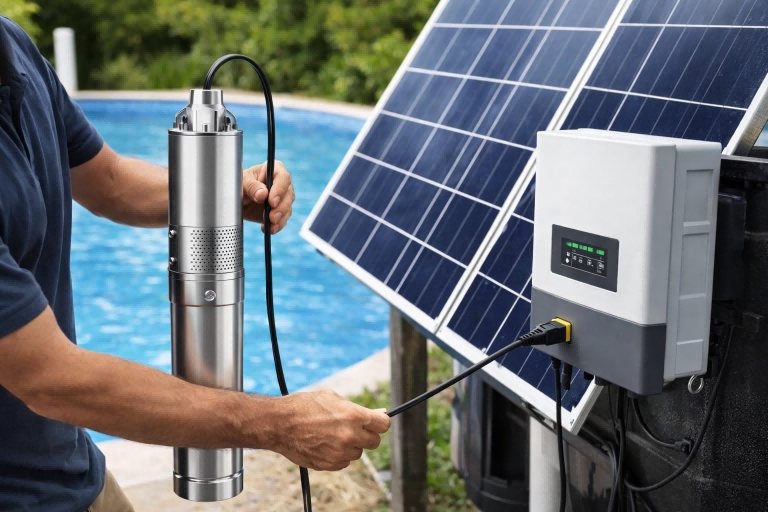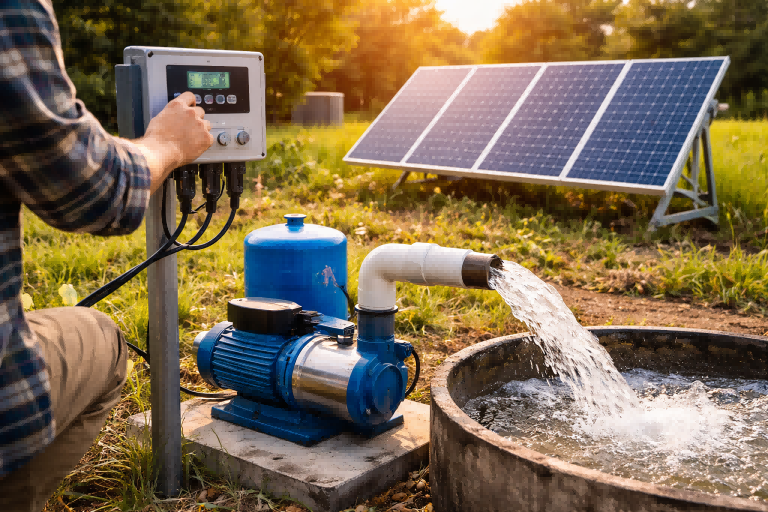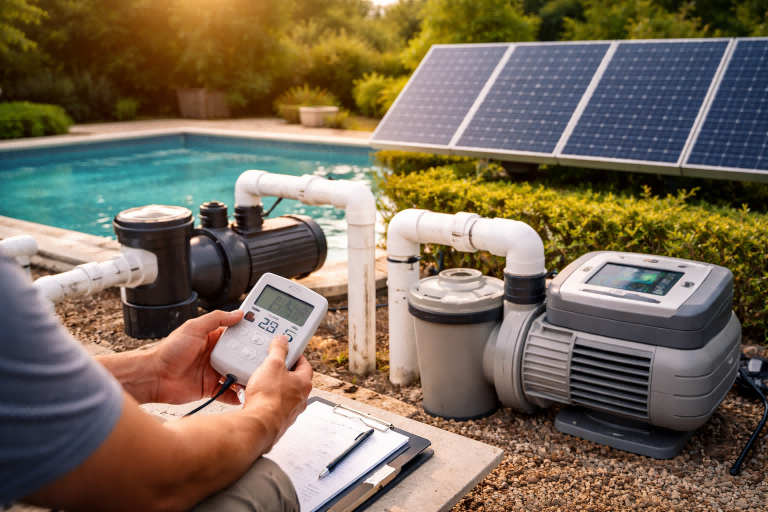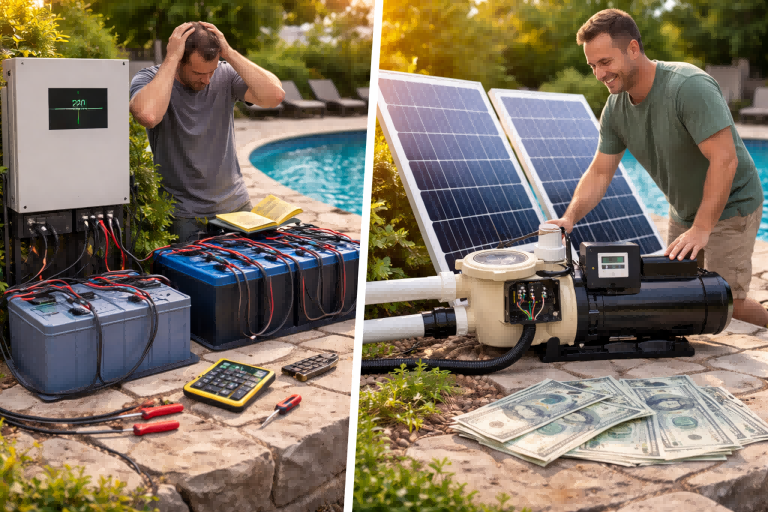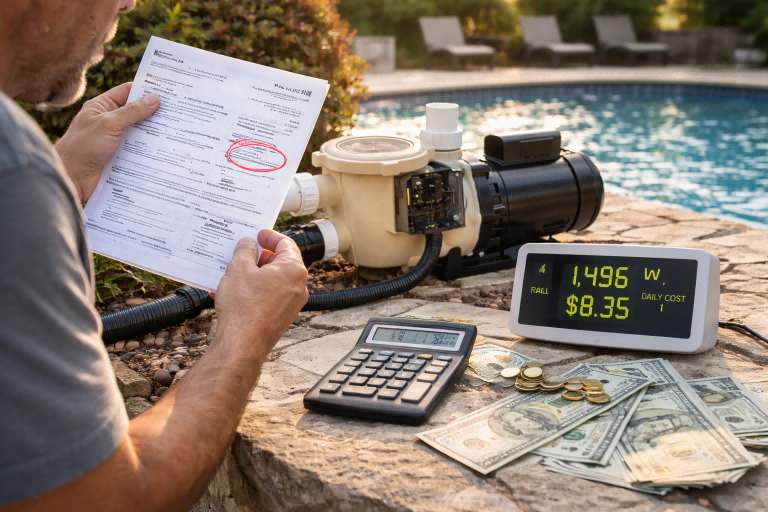Struggling with weak showers or inconsistent water flow?
An undersized pump can't meet your home's demand, leading to frustration.
Properly sizing your pump ensures strong, constant pressure for every faucet.
To size a water pump for a house, you must determine two key factors: the required flow rate in Gallons Per Minute (GPM) and the Total Dynamic Head (TDH) in feet. Match these calculations to a pump performance curve to find a model that operates efficiently at your specific duty point.

Choosing a water pump can feel like a complex, restrictive task.
You are given a set of needs, much like being handed a topic you must master, and expected to find the perfect solution.
The technical specifications and calculations can seem overwhelming, potentially leading to a poor choice that fails to perform.
But what if you had a clear guide?
A method that breaks down the process into simple, manageable steps.
This article will act as your guide, transforming this daunting challenge into a straightforward process.
We will walk you through each calculation, from flow rate to pressure, ensuring you have the knowledge to select a pump that delivers a steady, reliable flow of water exactly when you need it.
Let's begin this journey and unlock the power of a perfectly sized water system.
Understanding Your Home's Water Demand (GPM)
Confused about how much water your home actually uses?
Guessing your flow rate can lead to buying a pump that is either too weak or too powerful.
Calculating your peak demand ensures you select a pump that perfectly matches your household's needs.
To determine your home's water demand, count the number of water fixtures (sinks, showers, toilets). Add up their corresponding "fixture unit" values, then convert this total into the required Gallons Per Minute (GPM). This GPM figure represents your peak water usage requirement.
What are Water Fixtures?
Water fixtures are any points in your home where water is used.
This includes everything from faucets and showers to appliances like dishwashers and washing machines.
Each fixture requires a certain amount of water to operate correctly.
Understanding them is the first step in calculating your home's total water demand.
Calculating Fixture Units
Instead of adding up the maximum GPM of every single fixture, which is unrealistic, we use a system called "fixture units".
A fixture unit is a standardized value assigned to each type of fixture.
This method accounts for the fact that you will likely never use every single water source in your home at the exact same time.
To start, list every water-using fixture and appliance in your house.
Then, assign the correct fixture unit value to each one from a standard table.
| Fixture Type | Fixture Units (FU) |
|---|---|
| Bathroom Sink Faucet | 1 |
| Kitchen Sink Faucet | 2 |
| Full Bathroom (Toilet, Sink, Tub/Shower) | 6 |
| Half Bathroom (Toilet, Sink) | 3 |
| Bathtub | 2 |
| Separate Shower | 2 |
| Dishwasher | 2 |
| Clothes Washer | 3 |
| Garden Hose Bib | 3 |
Converting Fixture Units to Gallons Per Minute (GPM)
Once you have the total number of fixture units for your home, you need to convert this value into the flow rate your pump must deliver, measured in Gallons Per Minute (GPM).
This conversion is not a one-to-one calculation.
It follows a standardized curve that reflects the decreasing probability of simultaneous use as the number of fixtures increases.
Use a conversion chart to find the GPM that corresponds to your total fixture units.
| Total Fixture Units | Peak Demand (GPM) |
|---|---|
| 5 | 5 |
| 10 | 8 |
| 15 | 11 |
| 20 | 14 |
| 30 | 18 |
| 40 | 22 |
| 50 | 25 |
| 60 | 28 |
A Real-World Example Calculation
Let's imagine a typical single-family home.
We need to calculate its peak water demand.
-
List Fixtures:
- 2 Full Bathrooms (2 x 6 FU) = 12 FU
- 1 Kitchen Sink Faucet = 2 FU
- 1 Dishwasher = 2 FU
- 1 Clothes Washer = 3 FU
- 1 Garden Hose Bib = 3 FU
-
Sum Fixture Units:
12 + 2 + 2 + 3 + 3 = 22 Total Fixture Units. -
Convert to GPM:
Looking at our conversion chart, 22 fixture units falls between 20 and 30.
We can estimate the required flow rate to be approximately 15 GPM.
This 15 GPM figure is the first critical piece of information you need to size your water pump.
It tells you the volume of water the pump must be capable of moving to satisfy your home's busiest moments.
Calculating Total Dynamic Head (TDH)
Worried that your pump won't be strong enough to push water where it's needed?
If you only consider the pump's power, you might ignore the total resistance in your system.
Calculating the Total Dynamic Head is essential for ensuring your pump delivers adequate pressure to every faucet.
Total Dynamic Head (TDH) is the total resistance a pump must overcome. It is calculated by adding the vertical lift (the height the water is pumped), the friction loss from pipes and fittings, and the required operating pressure at the destination, all converted to feet.
The Three Components of TDH
Total Dynamic Head may sound complex, but it is simply the sum of three distinct types of resistance in your water system.
To choose the right pump, you must understand and calculate each one.
The pump's job is to overcome this combined pressure.
- Vertical Lift (Static Head): The vertical distance the pump must move the water.
- Friction Loss: The resistance created as water moves through pipes and fittings.
- Pressure Head: The desired water pressure at the faucets, converted into an equivalent height in feet.
Measuring Vertical Lift
Vertical lift is the gravitational force the pump must work against.
It is composed of two parts.
- Suction Head: The vertical distance from the water source (like a well or tank) up to the pump's inlet.
- Discharge Head: The vertical distance from the pump's outlet up to the highest point of use in your house (e.g., a second-floor shower).
Vertical Lift is the sum of these two distances.
For example, if the pump is 20 feet above the well water level (suction head) and the highest shower is 25 feet above the pump (discharge head), your total vertical lift is 45 feet.
Understanding Friction Loss
As water flows through pipes, it rubs against the inner walls, creating friction.
This friction acts as a resistance that the pump has to overcome.
The amount of friction loss depends on several factors.
- Pipe Diameter: Smaller pipes cause more friction than larger pipes for the same flow rate.
- Pipe Material: Rougher pipe materials (like old iron) create more friction than smooth materials (like PVC).
- Flow Rate (GPM): The faster the water moves, the greater the friction loss.
- Pipe Length: Longer pipes result in more total friction.
- Fittings: Every elbow, tee, and valve adds to the total friction loss.
You can find detailed charts online that provide the friction loss in feet of head for every 100 feet of pipe, based on pipe size, material, and GPM.
| Pipe Diameter (Sch 40 PVC) | Friction Loss (feet) per 100 ft at 10 GPM | Friction Loss (feet) per 100 ft at 15 GPM |
|---|---|---|
| 1" | 9.0 | 19.1 |
| 1.25" | 2.8 | 5.8 |
| 1.5" | 1.5 | 3.1 |
| 2" | 0.4 | 0.9 |
Accounting for Pressure Requirements
The final piece of the TDH puzzle is the water pressure you want at your fixtures.
This is typically measured in Pounds per Square Inch (PSI).
Most homes operate comfortably with a pressure between 40 and 60 PSI.
To include this in the TDH calculation, you must convert your desired PSI into an equivalent height in feet, known as "Pressure Head".
The conversion is simple.
1 PSI = 2.31 feet of head.
So, if you want a minimum of 50 PSI at the highest faucet, your Pressure Head would be 50 PSI * 2.31 = 115.5 feet.
Step-by-Step TDH Calculation
Let's put it all together with an example.
- Vertical Lift: 45 feet.
- Friction Loss: Assume 200 feet of 1.25" PVC pipe and a flow rate of 15 GPM. The chart shows 5.8 ft of loss per 100 ft. So, (200 ft / 100 ft) * 5.8 = 11.6 feet. Let's add ~30% for fittings, making it roughly 15 feet.
- Pressure Head: 50 PSI desired pressure. 50 * 2.31 = 115.5 feet.
Total Dynamic Head (TDH) = Vertical Lift + Friction Loss + Pressure Head
TDH = 45 ft + 15 ft + 115.5 ft = 175.5 feet.
Now you have the two critical values: 15 GPM and a TDH of 175.5 feet.
Reading a Pump Performance Curve
Do pump performance curves look like a foreign language to you?
Choosing a pump without understanding its curve is a total guess.
Learning to read this chart ensures you select a pump that will perform efficiently and reliably for your specific needs.
A pump performance curve is a graph showing a pump's capabilities. Locate your required flow rate (GPM) on the horizontal axis and your Total Dynamic Head (TDH) on the vertical axis. The ideal pump is one whose curve passes through or just above this intersection point.
The Axes of a Pump Curve
A pump curve chart provides a visual representation of a pump's performance.
It is the single most important tool for matching a pump to your calculated requirements.
The chart has two primary axes.
- The Horizontal Axis (X-axis): This represents the flow rate, usually measured in Gallons Per Minute (GPM) or cubic meters per hour (m³/h).
- The Vertical Axis (Y-axis): This represents the pressure the pump can generate, shown as Total Head in feet or meters.
The curve itself shows the inverse relationship between flow and head.
As the required flow rate (GPM) increases, the amount of pressure (Head) the pump can generate decreases.
Finding Your Duty Point
Your "duty point" or "operating point" is the specific combination of flow rate and head that your home's system requires.
You calculated this in the previous steps.
Let's use our example values: 15 GPM and 175.5 feet of TDH.
To find your duty point on the chart, you start by locating 15 GPM on the horizontal axis.
Then, you locate 175.5 feet on the vertical axis.
Imagine drawing a vertical line up from 15 GPM and a horizontal line across from 175.5 feet.
The point where these two lines intersect is your duty point.
Selecting the Right Pump Curve
Most pump specification sheets will show curves for several different models or impeller sizes on a single graph.
Your goal is to find a curve that passes directly through, or slightly above, your duty point.
- Curve Below Duty Point: If the pump's curve is significantly below your duty point, it will not be able to provide the required pressure and flow. This pump is too weak.
- Curve Far Above Duty Point: If the curve is far above your duty point, the pump is too powerful. It will work, but it will be inefficient, waste energy, and may be subject to excessive wear.
The ideal pump is one where your duty point falls on the main performance curve.
Understanding the Best Efficiency Point (BEP)
Many pump curves also include efficiency ratings, often shown as "islands" or contour lines on the graph.
The Best Efficiency Point (BEP) is the point on the curve where the pump operates with the highest efficiency, converting the most electrical energy into water movement.
Ideally, your duty point should be as close as possible to the pump's BEP.
Operating a pump at its BEP has several advantages.
- Energy Savings: The pump consumes the least amount of electricity for the work it is doing.
- Longevity: The pump experiences minimal vibration and hydraulic stress, leading to a longer service life.
- Reliability: Reduced stress on bearings, seals, and the motor means fewer breakdowns.
When you have a choice between two pumps whose curves are close to your duty point, choosing the one where your duty point is nearer to the BEP is the smarter, more cost-effective decision in the long run.
The Advantage of Variable Speed Drive (VSD) Pumps
Tired of high electricity bills from your water pump?
Traditional fixed-speed pumps always run at full power, even for low-demand tasks, wasting significant energy.
A Variable Speed Drive (VSD) pump automatically adjusts its speed to match demand, providing constant pressure while cutting energy use.
A VSD pump, also called an inverter booster pump, uses smart technology to maintain a constant water pressure regardless of how many faucets are open. It does this by adjusting its motor speed in real time, which can reduce electricity consumption by up to 50% or more.
How Fixed-Speed Pumps Waste Energy
A traditional, or fixed-speed, pump works like a light switch.
It is either completely off or running at 100% maximum speed.
These pumps are sized for your home's peak demand—that moment when multiple showers, faucets, and appliances are running at once.
However, this peak demand rarely occurs.
Most of the time, you are only using a single faucet or flushing a toilet, which requires much less flow.
A fixed-speed pump still runs at full blast for these small tasks, using far more energy than necessary.
This is like using a sledgehammer to tap in a small nail.
It is inefficient, noisy, and causes unnecessary wear and tear on the equipment.
The Smart Technology of VSD Pumps
A Variable Speed Drive (VSD) pump is fundamentally different.
It features an integrated controller (an inverter) that constantly monitors the pressure in your water line.
When you turn on a faucet, the pressure begins to drop.
The VSD controller senses this drop and smoothly ramps up the pump's motor speed just enough to meet the new demand and maintain your preset pressure.
If you turn on another faucet, the pump speeds up a little more.
When you turn the faucets off, the pump slows down or goes into a standby mode.
This intelligent adjustment has huge benefits.
| Feature | Fixed-Speed Pump | VSD Booster Pump |
|---|---|---|
| Motor Speed | Constant (100% On or Off) | Variable (Adjusts to demand) |
| Water Pressure | Fluctuates with demand | Perfectly constant |
| Energy Use | High, inefficient | Optimized, up to 50%+ savings |
| Noise Level | Loud, especially on startup | Very quiet operation |
| Equipment Lifespan | Shorter due to stress | Longer due to soft starts |
Key Benefits for Homeowners and Distributors
For the end-user, the most noticeable benefit of a VSD pump is the exceptional user experience.
The water pressure is always constant and strong, whether one person is showering or the entire house is active.
There are no more weak showers when the dishwasher starts.
The energy savings are also a major factor, leading to a lower total cost of ownership over the pump's life.
For distributors and importers, offering VSD pumps provides a significant competitive advantage.
You are providing a technologically superior product that solves common customer complaints like fluctuating pressure and high energy costs.
These pumps represent the modern standard in residential water supply.
They are an easy-to-market solution that positions your business as a provider of high-quality, efficient, and intelligent water systems, which is what discerning customers like Andrew from Australia are looking for.
Conclusion
Sizing a water pump requires calculating your GPM demand and TDH.
Matching these to a pump curve ensures you select an efficient, reliable model that provides perfect, constant water pressure.
FAQs
What happens if my water pump is too big for my house?
An oversized pump will cycle on and off frequently, causing premature wear on the motor and electrical components. It also wastes a significant amount of energy, leading to higher electricity bills.
Can I replace my pump with a more powerful one?
You can, but it is often unnecessary and can cause problems. A much more powerful pump might create pressure that is too high for your plumbing system (water hammer), potentially leading to leaks.
How do I know if my well pump is the right size?
If you experience fluctuating water pressure, your pump cycles on and off rapidly, or your energy bills are unusually high, your pump may be sized incorrectly. The best way to know is to perform the GPM and TDH calculations.
What is the average size water pump for a house?
For an average-sized home (e.g., 3 bedrooms, 2 bathrooms), a pump providing 10-15 GPM is often sufficient. However, the required TDH can vary dramatically based on well depth and house elevation.
How long should a home water pump last?
A quality, properly sized water pump should last 8 to 15 years. VSD pumps often have a longer lifespan because their soft-start mechanism reduces mechanical stress on the motor and components.
Does a larger house need a larger water pump?
Generally, yes. A larger house usually has more bathrooms, appliances, and plumbing, which increases the peak water demand (GPM) and often the Total Dynamic Head (TDH), requiring a more capable pump.
What is better, a submersible or jet pump?
Submersible pumps are more efficient and better for deep wells (deeper than 25 feet) as they push water up. Jet pumps are ground-level pumps that pull water and are suitable for shallow wells or surface water sources.


